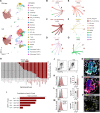This is a preprint.
Single-cell and spatial transcriptomics identify a macrophage population associated with skeletal muscle fibrosis
- PMID: 37131694
- PMCID: PMC10153153
- DOI: 10.1101/2023.04.18.537253
Single-cell and spatial transcriptomics identify a macrophage population associated with skeletal muscle fibrosis
Update in
-
Single-cell and spatial transcriptomics identify a macrophage population associated with skeletal muscle fibrosis.Sci Adv. 2023 Jul 7;9(27):eadd9984. doi: 10.1126/sciadv.add9984. Epub 2023 Jul 7. Sci Adv. 2023. PMID: 37418531 Free PMC article.
Abstract
The monocytic/macrophage system is essential for skeletal muscle homeostasis, but its dysregulation contributes to the pathogenesis of muscle degenerative disorders. Despite our increasing knowledge of the role of macrophages in degenerative disease, it still remains unclear how macrophages contribute to muscle fibrosis. Here, we used single-cell transcriptomics to determine the molecular attributes of dystrophic and healthy muscle macrophages. We identified six novel clusters. Unexpectedly, none corresponded to traditional definitions of M1 or M2 macrophage activation. Rather, the predominant macrophage signature in dystrophic muscle was characterized by high expression of fibrotic factors, galectin-3 and spp1. Spatial transcriptomics and computational inferences of intercellular communication indicated that spp1 regulates stromal progenitor and macrophage interactions during muscular dystrophy. Galectin-3 + macrophages were chronically activated in dystrophic muscle and adoptive transfer assays showed that the galectin-3 + phenotype was the dominant molecular program induced within the dystrophic milieu. Histological examination of human muscle biopsies revealed that galectin-3 + macrophages were also elevated in multiple myopathies. These studies advance our understanding of macrophages in muscular dystrophy by defining the transcriptional programs induced in muscle macrophages, and reveal spp1 as a major regulator of macrophage and stromal progenitor interactions.
Conflict of interest statement
Figures







References
-
- Masuda T., Sankowski R., Staszewski O., Prinz M., Microglia Heterogeneity in the Single-Cell Era. Cell Rep 30, 1271–1281 (2020). - PubMed
-
- Xiong X., Kuang H., Ansari S., Liu T., Gong J., Wang S., Zhao X. Y., Ji Y., Li C., Guo L., Zhou L., Chen Z., Leon-Mimila P., Chung M. T., Kurabayashi K., Opp J., Campos-Perez F., Villamil-Ramirez H., Canizales-Quinteros S., Lyons R., Lumeng C. N., Zhou B., Qi L., Huertas-Vazquez A., Lusis A. J., Xu X. Z. S., Li S., Yu Y., Li J. Z., Lin J. D., Landscape of Intercellular Crosstalk in Healthy and NASH Liver Revealed by Single-Cell Secretome Gene Analysis. Mol Cell 75, 644–660 e645 (2019). - PMC - PubMed
Publication types
Grants and funding
LinkOut - more resources
Full Text Sources
Research Materials
Miscellaneous
